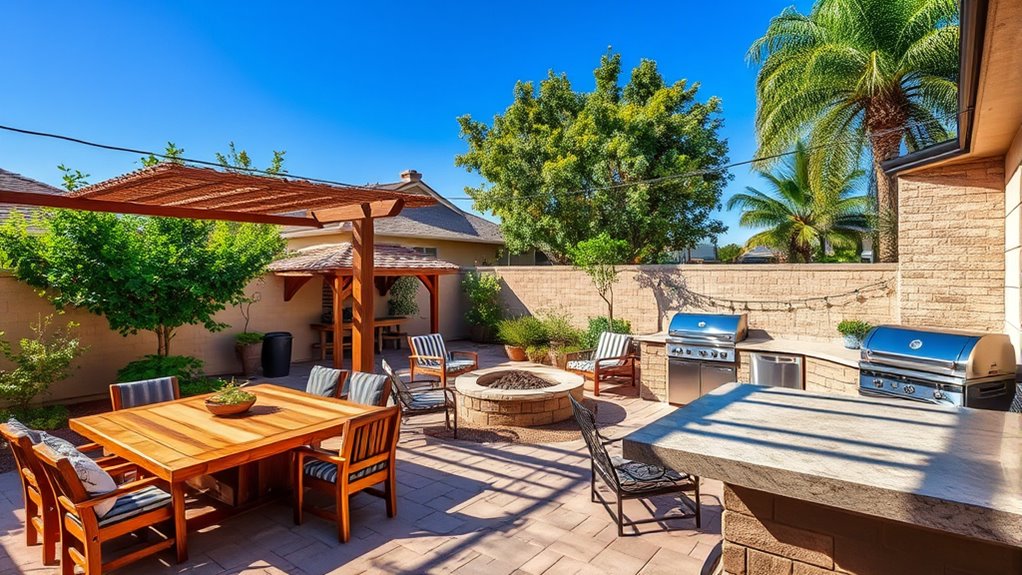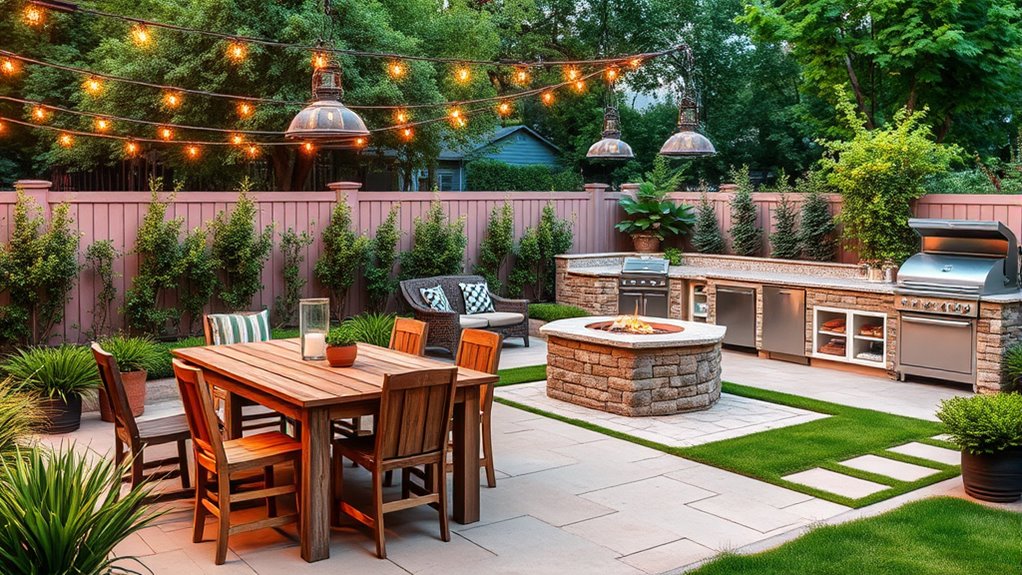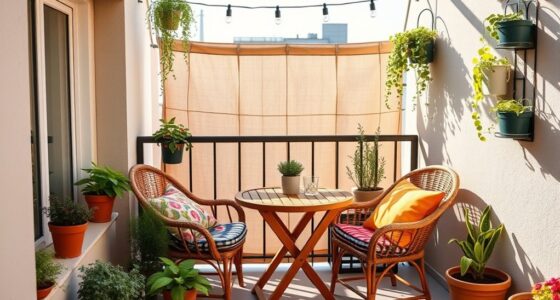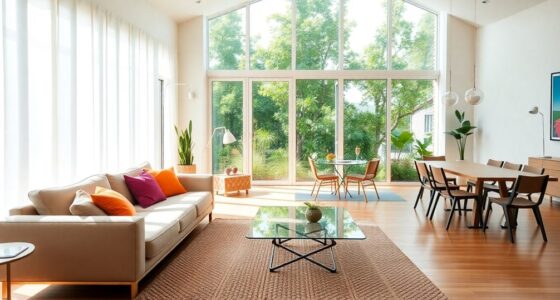To effectively zone your outdoor space, clearly define areas for dining, cooking, and relaxation. Position the dining spot near your outdoor kitchen for easy flow, and use surface changes like pavers or decks to distinguish zones visually. Add privacy screens, lighting, and natural elements to enhance both function and beauty. Thoughtful zoning creates a seamless, inviting outdoor environment. Keep exploring how to optimize each area for maximum enjoyment and privacy.
Key Takeaways
- Clearly define and position dining, cooking, and relaxation zones for optimal functionality and flow.
- Use surface materials and layout changes to visually distinguish each outdoor zone.
- Incorporate privacy screens like plants or panels to create intimate, secluded areas.
- Place the cooking area near the dining space with adequate safety and movement space.
- Add lighting and natural elements to enhance ambiance and usability during evening hours.

Have you ever wondered how to make the most of your outdoor space? One effective way is to carefully plan and zone different areas for dining, cooking, and relaxation. When you approach your yard with a clear vision for landscape design, you create a cohesive flow that maximizes functionality and comfort. Start by visualizing what you want each zone to accomplish. For example, your dining area should be close enough to your kitchen or outdoor cooking station for easy access but separated enough to avoid noise and distractions. This zone can be defined with a change in surface material, such as paving stones or a wooden deck, to visually distinguish it from other areas.
Carefully plan outdoor zones for dining, cooking, and relaxation to create a functional, cohesive landscape.
Next, consider privacy screens to enhance each zone’s usability. Privacy screens are essential for creating intimate dining and relaxation spots, especially if your yard is visible from neighbors or the street. You can incorporate tall plants, lattice panels, or decorative fencing to block unwanted views while adding aesthetic appeal. These screens not only provide seclusion but can also serve as backdrop elements in your landscape design, framing your outdoor living spaces beautifully. When selecting privacy screens, think about the overall style of your yard and choose materials and plants that complement your existing landscape.
For your cooking area, proximity is key. Position your grill or outdoor kitchen close to the dining table, but keep enough space for movement and safety. Incorporate a shaded pergola or a retractable canopy over these zones to offer relief from the sun and rain. This setup encourages seamless transitions between cooking and dining, making outdoor meals more enjoyable. Use landscape design principles to arrange surrounding elements like planters, lighting, and seating to create a cohesive environment. Soft lighting, such as string lights or lanterns, can add warmth and ambiance once the sun sets, making your outdoor cooking and dining experience more inviting. Additionally, utilizing vegetable juices or incorporating fresh herbs from your garden can elevate your outdoor culinary experience.
For your relaxation zone, prioritize comfort and tranquility. Place it away from the cooking and dining areas to minimize noise and odors. Use natural elements like water features, lush plants, or a fire pit to foster a peaceful atmosphere. Privacy screens here can be more permeable, like a row of tall grasses or decorative screens that allow airflow but obscure direct sightlines. Add comfortable seating, cushions, and maybe even a hammock or swing to encourage leisure. Carefully zoning your outdoor space with these considerations guarantees that each area serves its purpose and that your yard becomes a versatile extension of your home, perfect for entertaining or unwinding anytime you desire.
Frequently Asked Questions
What Are the Best Materials for Durable Outdoor Furniture?
You should choose outdoor furniture made from durable, weather-resistant materials like aluminum, teak, or synthetic wicker, which withstand the elements. Opt for weather-resistant fabrics for cushions, ensuring they resist fading and moisture. Additionally, consider sustainable materials such as recycled plastics or responsibly sourced wood, which offer longevity and eco-friendliness. These choices help your outdoor space stay stylish and functional year-round, with minimal upkeep.
How Can I Enhance Privacy in Outdoor Dining Areas?
Think of your outdoor dining area as a hidden garden sanctuary. You can enhance privacy by choosing fencing options like tall wooden panels or vinyl fences for a natural barrier. Adding privacy screens, such as lattice panels with climbing plants or outdoor curtains, creates a cozy, secluded feel. These solutions block prying eyes and turn your space into a peaceful retreat where you can relax and dine undisturbed.
What Are Safety Considerations for Outdoor Cooking Zones?
You should prioritize fire safety by keeping a fire extinguisher nearby and ensuring your grill is stable and away from flammable materials. Watch out for electrical hazards by inspecting outdoor outlets and cords for damage, avoiding overloading circuits, and using weatherproof equipment. Always supervise your cooking zone, and maintain a clear, clutter-free space to prevent accidents. These steps help keep your outdoor cooking safe and enjoyable.
How Do Zoning Laws Affect Outdoor Entertainment Setups?
Zoning laws influence your outdoor entertainment setups by imposing restrictions that you must follow. Zoning restrictions determine where you can place features like patios, fire pits, or outdoor speakers, ensuring safety and neighborhood harmony. Setback requirements specify the minimum distance these features must be from property lines or structures. By understanding and adhering to these rules, you can design a functional, compliant outdoor space that enhances your entertainment options without legal issues.
What Lighting Options Are Ideal for Outdoor Relaxation Zones?
You should consider solar string lights and LED landscape lighting for your outdoor relaxation zone. Solar string lights create a warm, inviting atmosphere, perfect for evening gatherings without extra wiring. LED landscape lighting highlights pathways and features, adding ambiance and safety. Combining these options gives your space a cozy glow, enhances its appeal, and is energy-efficient. These lighting choices make your outdoor retreat both functional and beautifully illuminated.
Conclusion
Designing your outdoor domain with deliberate divisions transforms chaos into charm. By blending borders, benches, and beautiful blooms, you create a cohesive, enchanting haven. Focus on functional zones for dining, cooking, and relaxing, ensuring each space serves its purpose perfectly. With thoughtful touches and strategic separation, your outdoor oasis becomes a place of peaceful pleasure and practical perfection. Bring boundaries and beauty together for a balanced, breathtaking backyard that beckons you to bask, bond, and blissfully break away.









